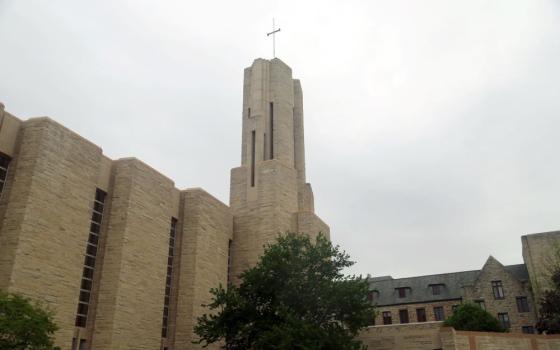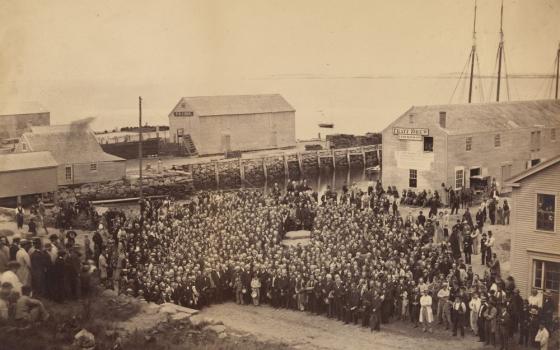By JOHN L. ALLEN JR.
New York
A more traditional and “Roman” translation of the Mass into English currently in the pipeline may dampen enthusiasm for wider use of the pre-Vatican II Mass, according to the executive director of the commission charged with preparing that translation.
“I suspect many traditionalists may be better satisfied by what we’re offering” than by the existing vernacular translation, said Fr. Bruce Harbert, executive director of the International Commission on English in the Liturgy, a project of 11 English-speaking bishops’ conferences which prepares translations of liturgical texts.
Current speculation suggests that Pope Benedict XVI may be on the verge of widening permission for celebration of the so-called "Tridentine rite," the Latin Mass in use prior to the Second Vatican Council (1962-65), at the same time that a new translation of the post-Vatican II Mass into English is nearing completion. Complaints from some Catholics about alleged deficiences in the first vernacular translation of the Mass, according to many experts, have helped fuel nostalgia for the old rite.
In keeping with the 2001 Vatican document Liturgiam authenticam, which laid out new rules for the translation process, ICEL has prepared a new text of the Order of Mass which has now been approved by all major English-speaking conferences except India. The translation is deliberately closer to the original Latin in style, structure and even word choice.
In one highly publicized example, the new translation uses “and with your spirit” rather than the familiar “and also with you” to translate Et cum spiritu tuo when the congregation responds to the celebrant’s greeting, “Peace be with you.”
In an Oct. 23 telephone interview from Manchester, England, Harbert said that the attraction of the older, pre-Vatican II Mass for some Catholics has to do with a perceived lack of reverence in the way the post-Vatican II Mass is at times celebrated.
“Sometimes the music, or a perceived informality on the part of the celebrant, is what turns people off,” he said. In that light, he said, a translation closer to the spirit of the Latin original, with a more formal and “sacred” tone, could help.
At the same time, Harbert said that liberalized use of the pre-Vatican II Mass, if such a ruling does come from Pope Benedict XVI, would not have any impact on the way ICEL approaches translation of the post-Vatican II Mass.
“It’s completely separate,” he said. “I can’t see it exerting any pressure at all, one way or the other.”
Harbert said he doesn’t believe that translators or liturgists who have worked for almost a decade on the new translation would be demoralized by a papal decision to broaden use of the old rite, feeling that their efforts would be of lesser importance.
“I don’t know anybody who thinks that,” he said.
In terms of the potential impact of wider permission for celebration of the old rite, Harbert said it may vary by country. In England, he said, he suspected it would make little difference, since England “has always had a more generous indult,” meaning permission to celebrate the older Mass.
“Cardinal [John] Heenan got a generous permission from Pope Paul VI,” Harbert said, referring to the late Archbishop of Westminster, who died in 1975. “Most bishops have put themselves out to make sure the older Mass is available, at least in the large centers of population.”
Harbert, a priest of the English archdiocese of Birmingham, said the numbers who take advantage of the older Mass vary, but in general remain fairly small. He cited the case of Manchester, where a large university parish offers the pre-Vatican II Mass on Sunday afternoons at 4:00 pm.
“Fairly large numbers come, but in part it has to do with the convenient time,” Harbert said, noting that many congregants receive communion on the hand and say “amen” when presented with the host, both gestures alien to the pre-Vatican II rite.
Harbert said he recently attended the older rite at a parish in Virginia, where once again the church “was packed.” There, he said, the congregation initially joined in reciting the “Our Father” in Latin – another touch which was not part of the pre-Vatican II liturgy.
All this suggests, Harbert said, that it may not be the older rite itself which is the issue for many Catholics, so much as a liturgical style they perceive to be sober, reverent, and grounded in tradition.
Harbert said debates over the older Mass are “more of an issue” in the United States, where its availability varies diocese by diocese. In any event, Harbert predicted, the post-Vatican II Mass in the vernacular will remain the normal liturgical experience for the vast majority of Catholics.
Earlier in October, Harbert was in Rome for a meeting of ICEL’s Editorial Committee, which is currently working on texts such as the Proper of Seasons and the Proper of Saints to complete the Roman Missal. Currently, the ICEL translation of the Order of Mass, which has been approved by the bishops of the United States and other English-speaking countries, is awaiting review by the Congregation for Divine Worship and the Discipline of the Sacraments.
The ICEL bishops will meet as a body in January in Capetown, South Africa.




